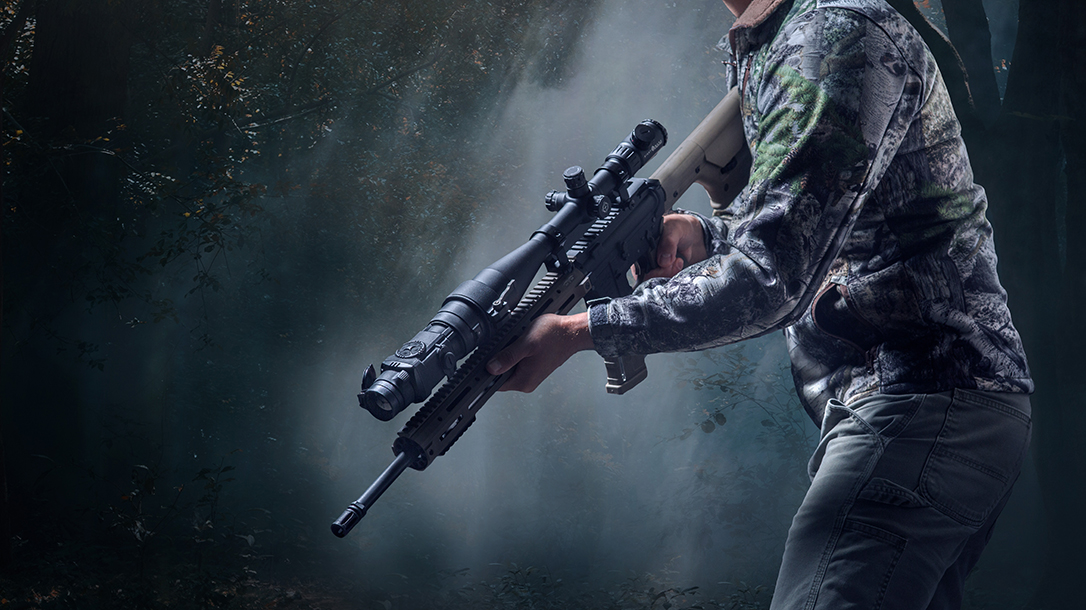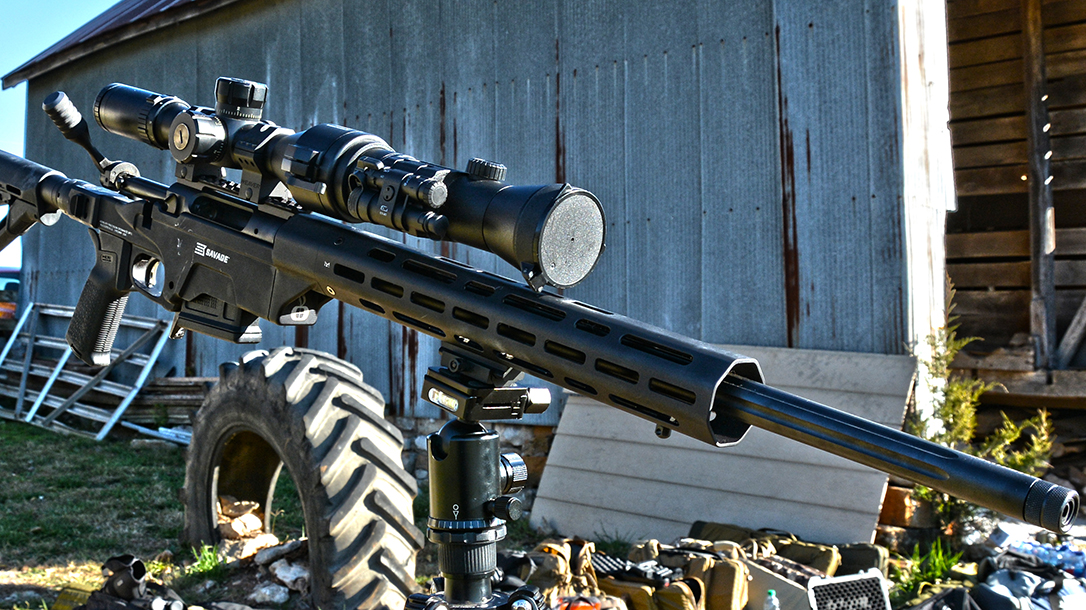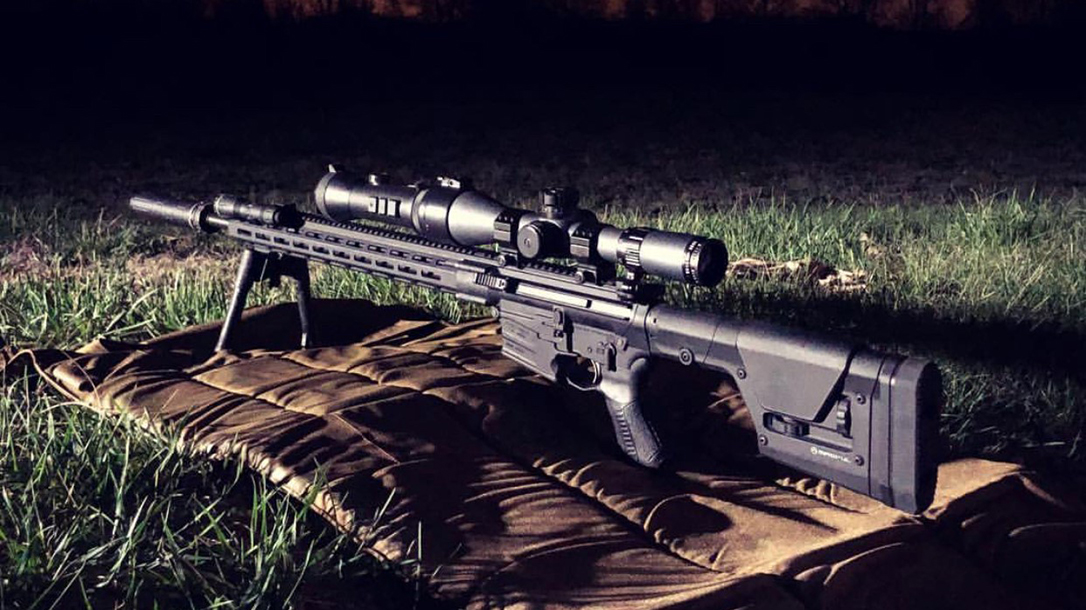One of the issues every shooter must overcome when integrating stealth technology like image-intensification and thermal devices into their inventory is how to mesh the tools used during daylight hours with the tools used during low-light hours. Rifles require optics and iron sights for redundant aiming systems during the day. When darkness falls, those same guns need white and infrared lights for searches and identifying people or objects, plus an infrared laser and either a dedicated night optic or what is referred to as a Clip On Night Vision device that attaches to the day scope for aiming once a target is found and identified. There are advantages and disadvantages to each setup. But the concept of a clip-on night sight that attaches to your existing day scope is tremendously appealing for a number of reasons.
Clip On Night Vision Pros & Cons
Clip-on night vision devices attach to the rifle in front of the day scope. Attachment is usually accomplished by placing the NVD on an extended Picatinny rail or on a forend bracket with a Picatinny rail. Some clip-on optics attach directly to the riflescope. Meanwhile, others attach to a special mount that replaces the top of the forward scope ring.
Advertisement — Continue Reading Below
Using a clip-on in front of the day optic allows the shooter to use the same familiar scope, reticle, adjustment knobs and other controls he or she trained on during daylight hours for night operations as well. In this mode, there is no reticle in the clip-on optic, and all of the aiming is done with the reticle of the day optic. The clip-on merely presents the field of view and target image to the day optic. Some clip-ons are also capable of working in standalone mode where the clip-on becomes the sole optic. Here, it provides both the target image and the aiming point. The advantages of using the same day scope during night operations are lost in this configuration, however.
Clip On Night Vision in the Military
Perhaps the most dominant use of the clip-on NVD is in long-range military observation and sniping roles. Our military snipers have successfully used clip-ons like the PVS-27 Magnum Universal Night Sight (MUNS) for years. The training and proficiency benefits that come with maintaining one day-scope system for 24-hour use is significant. The same zero is maintained, the same ballistic data and resulting aiming corrections are maintained, and the controls required to make those corrections feel the same during day or night. The elevation-adjustment knob is always in the same place, always turns the same direction, and each adjustment increment always has the same “clicks” as it is turned. The same goes for the windage-adjustment knob. This facilitates rapid engagement and consistency of operation, which are both obvious benefits.
Using Clip On Night Vision Devices
If there is a downside to the most common clip-on NVDs, it is the use of image-intensification technology, which relies on available light to process and present an image to the day optic. As the amount of light increases, the performance of the clip-on increases. Conversely, on those dark, moonless, overcast nights, the range of the clip-on will be significantly limited and may require additional illumination from an infrared device. This also has advantages and disadvantages.
Advertisement — Continue Reading Below
For the military sniper working against a night-vision-equipped adversary, using an infrared illuminator is like turning on a glowing beacon that says, “Drop artillery here!” On the other hand, the sniper’s spotter, who often has a clip-on mounted in front of a spotting scope, or the sniper himself can watch the bullet fly to the target by observing the reflection of the infrared light off the base of the bullet. This makes spotting impacts and correcting for a follow-up shot easier than doing so during some daylight conditions when watching the trace of the bullet. If you’re an enthusiast looking to ring some steel targets after hours, then using infrared illumination isn’t a big deal.
Mounting a clip-on in front of your day scope also takes advantage of the day scope’s magnification and ability to zoom in or out. Night-vision devices generally only have digital zooms that significantly degrade in quality as magnification increases. Since day scopes use optical zoom, there is no degradation or pixilation of the image as magnification is increased. Since the exit pupil decreases with increased magnification, there will be a reduction of light transmission, however. Some clip-on models will perform well only up to moderate magnification levels.
Going Thermal?
The ability to utilize the day scope’s optical zoom ties into the primary benefit of an image-intensifying clip-on over a thermal clip-on: identification. There is no doubt that a thermal scope or thermal clip-on will make detection—simply realizing the presence of a target—easier. Identifying that target, however, is usually easier with an image-intensifying device due to the increased detail available through such an optic. When you are operating under the sort of rules of engagement or use-of-force criteria that our military snipers and law enforcement marksmen work with, positively identifying the guy who just walked up to the building you’re observing is mandatory. There’s a big difference between “a tall guy with a beard and a funny hat just entered the building” and “Osama bin Laden just entered the building.” The increased detail available through an image-intensifying device facilitates positive identification.
Advertisement — Continue Reading Below
Is there a place for a thermal clip-on? You bet. For the around-the-clock hunter, a thermal clip-on is a great option. You’ve set up your stand during daylight hours. You’ve zeroed and practiced with your day optic. You know the controls and are comfortable and confident in its use. After sunset, you simply clip on your thermal and the heat signatures from the animals are instantly visible. For that matter, you can use the thermal clip-on during the day as well.
Further Considerations on Clip On Night Vision
Turn on your image-intensifying clip-on in broad daylight and you’ll quickly ruin it. Points go to the thermal in this case. Another option is to use your thermal clip-on as a handheld monocular during daylight hours. You can detect heat signatures where animals may be hiding by using the thermal to scan. Once you locate the heat signature, use your day optic to zoom in. Then identify the target and take the shot if desired.
Keep in mind that you won’t be able to watch bullet trace or see your impacts unless there is some sort of thermal signature created by those impacts. Several years ago I spent a few days at Fort Riley, Kansas, with some soon-to-deploy snipers. Impacts on steel targets and misses into the surrounding gravel were easy to spot through the high-end thermal viewers. When we hit steel, there was an obvious thermal signature created as the bullet impacted the target. If missed (not that I missed or anything) into the gravel, sparks flew and corrections were easy to make. When our rounds impacted into grassy areas, however, no thermal signature was created. Those misses were very hard to call precisely unless you were following the signature of the bullet itself.
Advertisement — Continue Reading Below
To be fair, the same problems can exist with standard day optics in those conditions as well. One negative of the thermal clip-on is the reduced screen size of most units. If you want to use the optic in standalone mode or as a handheld scanner, you’ll have a reduced screen. Not the end of the world, but a possible consideration.
Clip On Night Vision Final Thoughts
As is often the case, the right tool for the job will be determined by your application and environment. If merely finding an animal or a person that is either well camouflaged or screened by light brush is adequate, the thermal excels during day or night. If detailed identification or long-range marksmanship with a spotter is your mission, an image-intensifying clip-on has some serious advantages.
This article is from the 2019 issue of Stealth magazine. Grab your copy at OutdoorGroupStore.com.
Advertisement — Continue Reading Below


























